1994 PONTIAC GRAND-AM cooling
[x] Cancel search: coolingPage 161 of 274
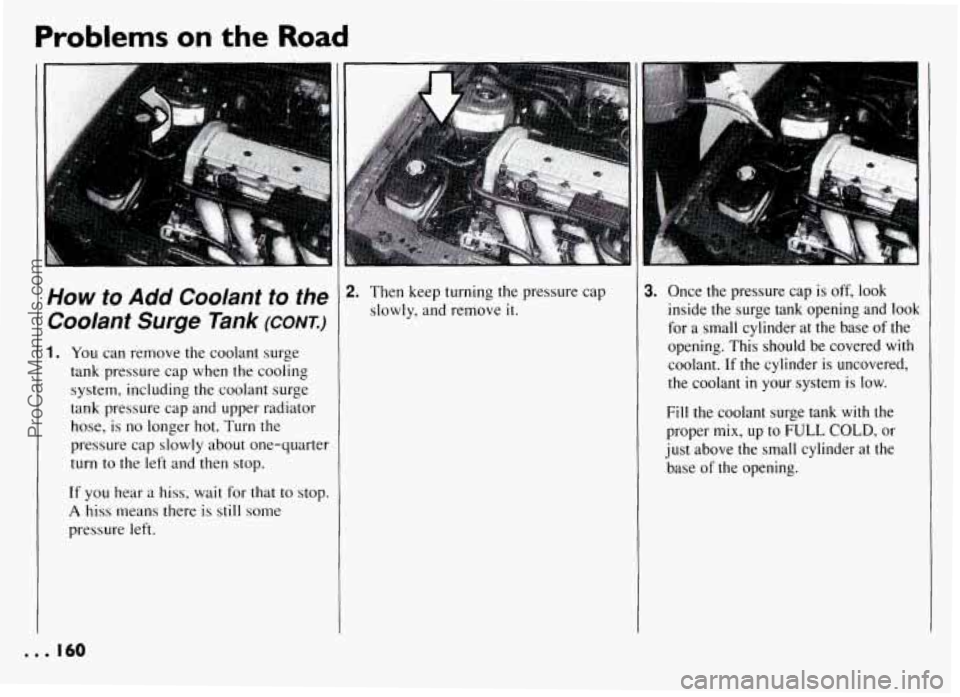
Problems on the Road
..
How to Add Coolant to the
Coolant Surge Tank
(CONK)
1. You can remove the coolant surge
tank pressure cap when the cooling
system, including the coolant surge
tank pressure cap and upper radiator
hose, is no longer hot. Turn the
pressure cap slowly about one-quarter
turn to the left and then stop.
If you hear a hiss, wait for that to stop.
A hiss means there is still some
pressure left.
2. Then keep turning the pressure cap
slowly, and remove it.
. Once the pressure cap is off, look
inside the surge tank opening and look
for a small cylinder at the base
of the
opening. This should be covered with
coolant. If the cylinder
is uncovered,
the coolant
in your system is low.
Fill the coolant surge tank with the
proper mix, up to FULL COLD, or
just above the small cylinder at the
base
of the opening.
... 160
ProCarManuals.com
Page 189 of 274

Service & Appearance Care
How to Check:
The proper fluid should be added if the
level is at or below the STEP mark on the
reservoir cap. See the instructions on the
reservoir cap.
Engine Coolant
The following explains your cooling
system and how to add coolant when
it is
low.
If you have a problem with engine
overheating, see “Engine Overheating”
in
the Index,
The proper coolant for your Pontiac will:
Give freezing protection down to
-34°F (-37°C).
Give boiling protection up to 262°F
( 128 “C).
Protect against rust and corrosion.
Help keep the proper engine
temperature.
Let the warning lights work as they
should.
What to Use
Use a mixture of one-half clean water
(preferably distilled) and one-half
antifreeze that meets “GM Specification
1825-M,” which won’t damage aluminum
parts.
You can also use a recycled coolant
conforming to GM Specification 1825-M
with a complete coolant flush and refill. If
you use this mixture, you don’t need to
add anything else. NOTICE:
If you use an improper coolant mix,
your engine could overheat and be
badly damaged. The repair cost
wouldn’t be covered by your
warranty. Too much water
in the
mix can freeze and crack the engine,
radiator, heater core and other parts.
... 188
ProCarManuals.com
Page 204 of 274

Your dealer will know the kind of wheel
you need.
Each new wheel should have the same
load carrying capacity, diameter, width,
offset, and be mounted the same way as
the one
it replaces.
If you need to replace any of your wheels,
wheel bolts, or wheel nuts, replace them
only
with new GM original equipment
parts. This way, you
will be sure to have
the right wheel, wheel bolts, and wheel
nuts for your Pontiac model.
NOTICE:
The wrong wheel can also cause
problems
with bearing life, brake
cooling, speedometer/odometer
calibration, headlight aim, bumper
height, vehicle ground clearance,
and tire or tire chain clearance to the
body and chassis.
Used Replacement Wheels
‘ire Chains
NOTICE:
If your Pontiac has P195/70R14,
P2 15/60VR 14, P195/65R 15 or
P205/55R16 size tires, don’t use tire
chains; they can damage your
vehicle.
If you have other tires, use tire
chains only where legal and on
when you must. Use only
SAE
Class “S” type chains that are the
proper size for your tires. Install
them on the front tires and tighten
them as tightly
as possible with the
ends securely fastened. Drive slowly and follow the chain
manufacturer’s instructions. If you
can hear the chains contacting your
vehicle, stop and retighten them. If
the contact continues, slow down
until- it stops. Driving too fast with
chains on will damage your vehicle.
lr
ProCarManuals.com
Page 216 of 274
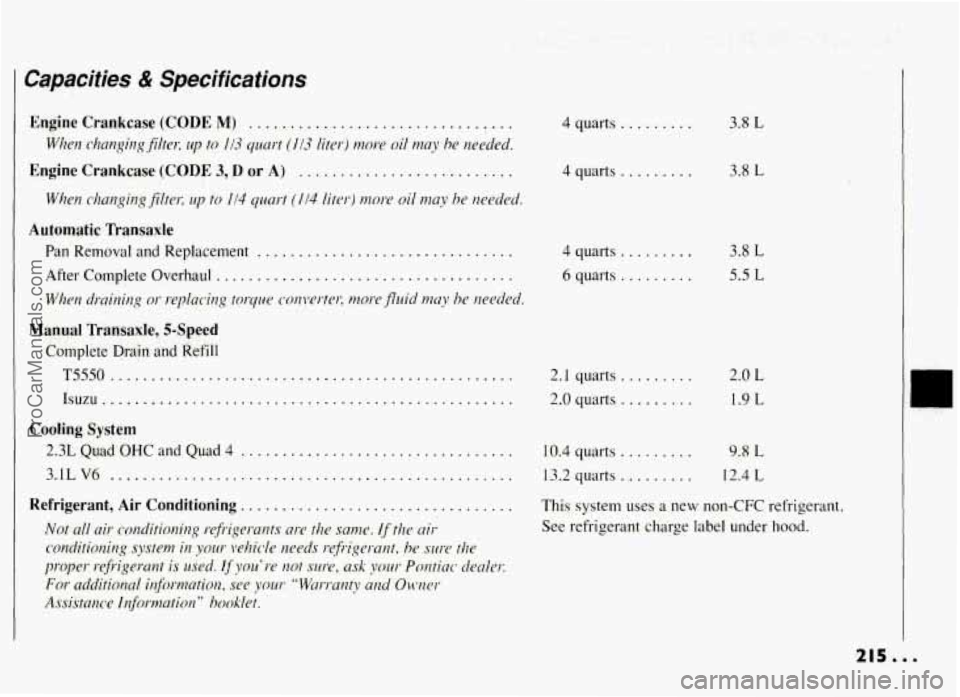
4quarts .........
4 quarts ......... 3.8 L
6 quarts ......... 5.5 L
Capacities & Specifications
Engine Crankcase (CODE M) ................................ 4 quarts ......... 3.8 L
When changing filter; up to /I3 quart (113 liter) more oil may he needed.
Engine Crankcase (CODE 3, D or A) ........................ . 3.8 L
When changing filter; up to 114 quart (114 liter) more oil may be needed.
Automatic Transaxle
Pan Removal and Replacement ...............................
After Complete Overhaul ....................................
When draining or ~-eplat*ing torque conl~erte~; more fluid may be needed.
Manual Transaxle, 5-Speed
Complete Drain and Refill
T5550 ................................................. 2.1 quarts ......... 2.0 L
Isuzu .................................................. 2.0quarts ......... 1.9 L
Cooling System
2.3L Quad OHC and Quad 4 ................................. 10.4 quarts ......... 9.8 L
3.1L V6 ................................................. 13.2 quarts. ......... 12.4 L
Refrigerant, Air Conditioning. ................................ This system uses a new non-CFC refrigerant.
Not all air conditioning refrigerants are the same. If the air See refrigerant charge label under hood.
conditioning system in your rvhic-le needs re$-igerant, he suse the
proper refrigerant is used. If you’re not sure, ask your Pontiac dealer,
For additional info)-mation, see your “Warranty and 0wwc.r
Assistance Information’’ hooklet.
215...
ProCarManuals.com
Page 229 of 274
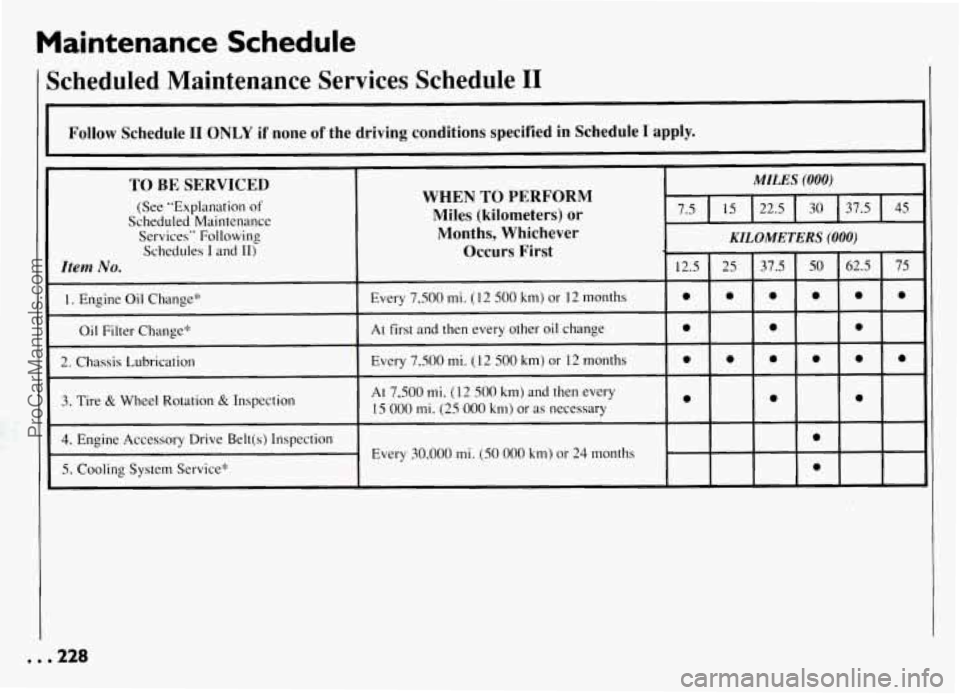
Maintenance Schedule
Scheduled Maintenance Services Schedule I1
Follow Schedule I1 ONLY if none of the driving conditions specified in Schedule I apply.
I
TO BE SERVICED
(See "Explanation of
Scheduled Maintenance Services" Following Miles (kilometers) or
Months, Whichever
KILOMETERS (000)
MILES (000)
WHEN TO PERFORM
Schedules I and 11,- Occurs First
Item No. 37.5 25
12.5
1. Engine Oil Change" Every
7,500 mi. ( 12 500 km) or 12 months
0,il Filter Change"
2. Chassis Lubrication At
first and then every other oil change
Every 7,500 mi. (12
500 km) or 12 months
0 0 0
0 0
0 0
0
3. Tire & Wheel Rotation & Inspection
4. Engine Accessory Drive Belt(s) Inspection
5. Cooling System Service*
At 7,500 mi. ( 12 500 km) and then every
15
000 mi. (25 000 km) or as necessary 0 0
Every 30.000 mi. (50 000 km) or 24 months
!
+
50 62.5
1
I
I.
t
. . .22a
ProCarManuals.com
Page 231 of 274
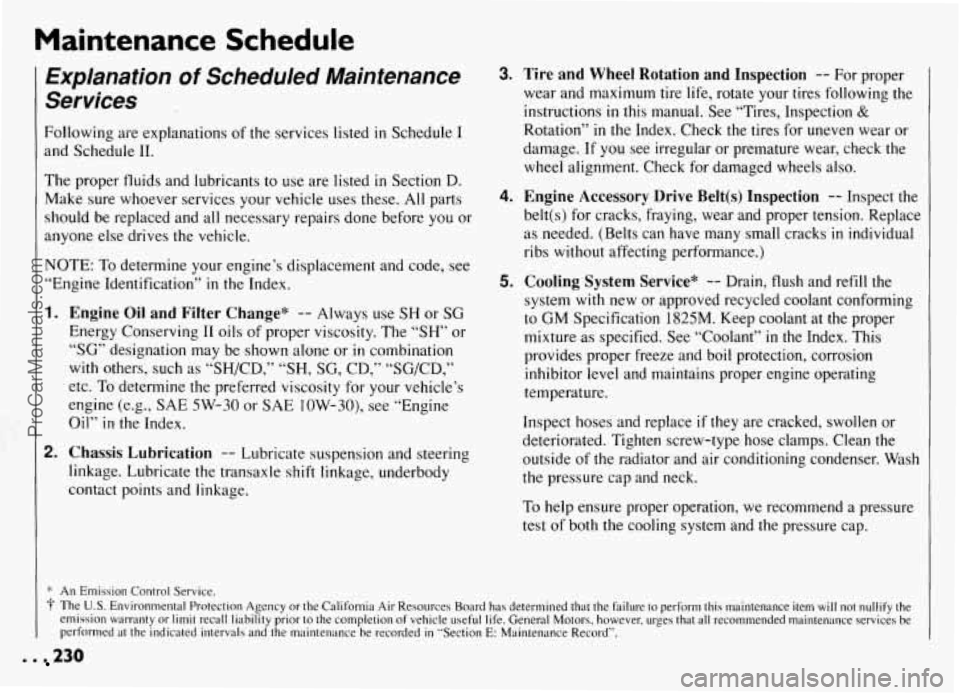
Maintenance Schedule
Explanation of Scheduled Maintenance
Services
Following are explanations of the services listed in Schedule I
and Schedule 11.
The proper fluids and lubricants to use are listed in Section D.
Make sure whoever services your vehicle uses these. All parts
should be replaced and all necessary repairs done before you or
anyone else drives the vehicle.
NOTE: To determine your engine’s displacement and code, see
“Engine Identification”
in the Index.
1.
2.
Engine Oil and Filter Change* -- Always use SH or SG
Energy Conserving I1 oils of proper viscosity. The “SH” or
“SG” designation may be shown alone or in combination
with others, such as “SH/CD,” “SH, SG, CD,” “SG/CD,”
etc. To determine the preferred viscosity for your vehicle’s
engine (e.g., SAE 5W-30 or SAE 10W-30), see “Engine
Oil”
in the Index.
Chassis Lubrication -- Lubricate suspension and steering
linkage. Lubricate the transaxle shift linkage, underbody
contact points and linkage.
3.
4.
5.
Tire and Wheel Rotation and Inspection -- For proper
wear and maximum tire life, rotate your tires following the
instructions
in this manual. See “Tires, Inspection &
Rotation” in the Index. Check the tires for uneven wear or
damage. If you see irregular or premature wear, check the
wheel alignment, Check for damaged wheels also.
Engine Accessory Drive Belt(s) Inspection -- Inspect the
belt(s) for cracks, fraying, wear and proper tension. Replace
as needed. (Belts can have many small cracks
in individual
ribs without affecting performance.)
Cooling System Service* -- Drain, flush and refill the
system with new or approved recycled coolant conforming
to
GM Specification 1825M. Keep coolant at the proper
mixture as specified. See “Coolant”
in the Index. This
provides proper freeze and boil protection, corrosion
inhibitor level and maintains proper engine operating
temperature.
Inspect hoses and replace if they are cracked, swollen or
deteriorated. Tighten screw-type hose clamps. Clean the
outside of the radiator and air conditioning condenser. Wash
the pressure cap and neck.
To help ensure proper operation, we recommend a pressure
test of both the cooling system and the pressure cap.
. . 230
ProCarManuals.com
Page 273 of 274
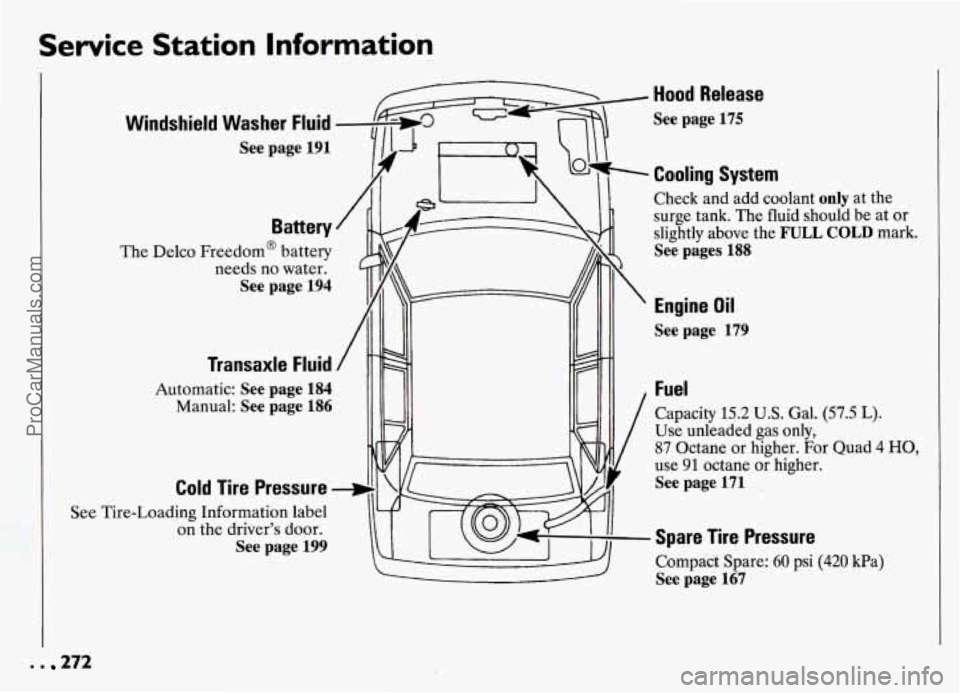
Service Station Information
See
7
Windshield Washer Fluid
Battery
The Delco Freedom@ battery
needs no water.
See page 194
Transaxle Fluid
Automatic: See page 184
Manual: See page 186
Cold Tire Pressure
Tire-Loading Information label
on the driver's door.
Seepage199
- Hood Release
See page 175
- Cooling System
Check and add coolant only at the
surge tank. The fluid should be at
or
slightly above the FULL COLD mark.
See pages 188
Engine Oil
See page 179
Capacity 15.2 U.S. Gal. (57.5 L).
Use unleaded gas only,
87 Octane or higher. For Quad 4 HO,
use 91 octane or higher.
See page 171 .
- Spare Tire Pressure
Compact Spare: 60 psi (420 kPa)
See page 167
. . 272
ProCarManuals.com